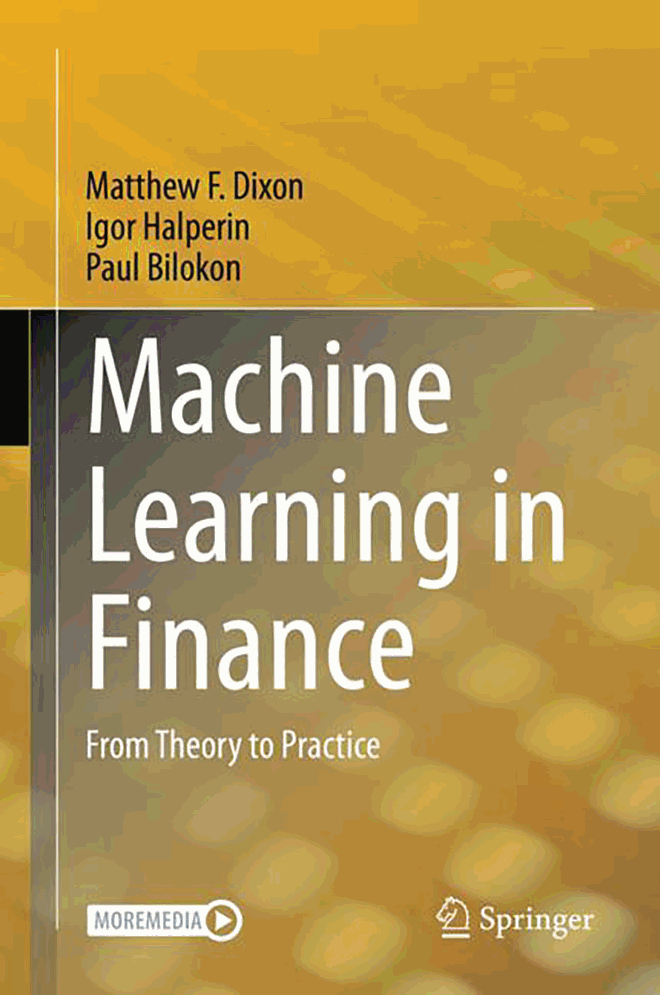
© 2020, Springer
The field of quantitative finance is increasingly relying on sophisticated statistical modelling techniques. Among those, the most fashionable discipline currently is undoubtedly machine learning (ML). While it is easy to find monographs dedicated to statistical learning or to computational finance, the combination of the two was scarce on the book market—until recently. Luckily, this volume aims to present a broad yet technical treatment of (ML) algorithms used by financial practitioners and scholars alike. The book is split in to three parts.
The first part pertains to traditional supervised learning algorithms, that is, when a dependent variable is explained by exogenous predictors in a possibly nonlinear fashion. It starts with a general introduction on the reasons behind the rise of big data and machine learning in the financial industry. The authors also briefly present the key ideas behind the most common tools used in practice. The mathematical content comes subsequently, with a particular focus on Bayesian learning (chapters 2 and 3), neural networks (chapter 4) and interpretability (chapter 5).
The second part focuses on what the authors call sequential learning, that is, trying to uncover patterns when data is indexed by time. It contains material on autoregressive models (chapter 6), filtering methods (chapter 7), and recurrent neural networks (chapter 8). Generative Adversarial Networks (GANs) and convolutional structures are also treated, though their relationship to time-series is less straightforward.
The third and last part is by far the longest and relates mostly to reinforcement learning (RL). Chapter 9 provides a tour of all important concepts in RL: the setting (agent, environment, action, rewards), the tools (Markov Decision Processes, dynamic programming) and the methods (Monte-Carlo simulations, Q-learning, policy gradient, etc.). Chapter 10 appears as the core of the book and surveys applications of RL in Finance. The first type of applications refers to derivatives pricing and hedging, and is handled with Q-learning.Footnote1 Portfolio choice problems are tackled with the so-called G-learning approach, which refines Q-learning by regularizing the Q function. The chapter ends with wealth management perspectives in which the investor is allowed to consume part of her financial gains or may save for a retirement plan. Chapter 11 deals with inverse RL and imitation learning, though their direct use in Finance is less obvious. The most prominent use-case seems to be the reverse-engineering of an investor's preferences or behaviour. The final chapter of the book provides some perspectives on recent trends that link Machine Learning, Finance and Physics. The authors propose a unified theory of financial decision making in which supervised learning would complement RL to increase its performance. This take is original and interesting, yet very abstract, as no tangible example is provided.
Overall, the book fills a large void. While the applications of ML in Finance are blossoming, no other monograph (to date) has provided an exhaustive treatment of the discipline. Most families of algorithms are covered and the authors tackle various classical problems encountered by practitioners. In addition, examples and code snippets (in Python) can be downloaded online. This encourages reproducibility as well as learning by doing, which is highly appreciated. A final warning though: some chapters require a solid mathematical background, especially in the second half of the book.
For the interested reader, the book has little overlap with two similar books published almost back-to-back. Lopez de Prado (Citation2020) is intended for the money management industry and covers such themes as clustering, data processing, and backtest overfitting (the latter being very important). Coqueret and Guida (Citation2020) is restricted to cross-sectional (factor) models, but they are studied in more depth. Jurczenko (Citation2020) aggregates chapters on particular topics, such as sparse regressions, natural language processing, and sentiment. It is important to learn from different perspectives, because the hype surrounding ML in Finance can be misleading. It is not easy to derive profits from neural networks—this requires deep knowledge and proficiency both in finance and computer science (or statistics). This unpopular take is seldom found in books, but is learned via experience.
Additional information
Notes on contributors
Guillaume Coqueret
Guillaume Coqueret is associate professor of finance and data science at EMLYON Business School. His research interests revolve around applications of numerical methods and machine learning in financial economics.
Notes
1 As is often done in the literature, the baseline benchmark is the Black-Scholes model. The adaptation of RL-based pricing and hedging to non-Gaussian and/or non i.i.d. returns seems like a promising research direction.
References
- Coqueret, G. and Guida, T., Machine Learning for Factor Investing, 2020 (CRC Press).
- Jurczenko, E., Machine Learning for Asset Management: New Developments and Financial Applications, 2020 (John Wiley & Sons).
- Lopez de Prado, M. M., Machine Learning for Asset Managers, 2020 (Cambridge University Press).
